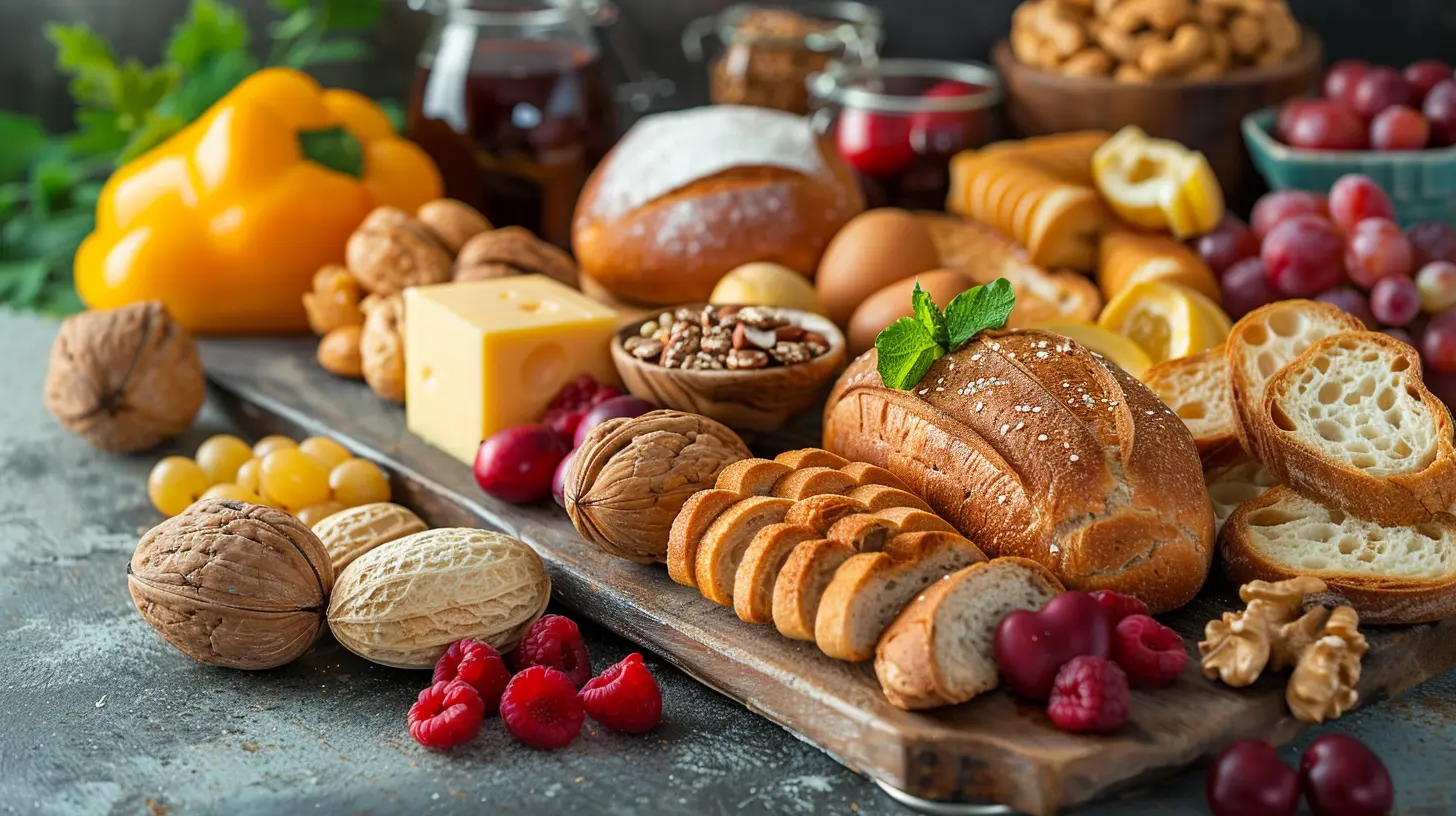Living with Nut Allergies: What to Eat and Avoid
22 May 2025
Living with nut allergies can feel like navigating a minefield—one wrong bite, and your body might sound the alarm. Whether you're newly diagnosed or have been managing it for years, knowing what to eat and what to avoid is crucial. The good news? With a little knowledge and careful planning, you can enjoy a delicious and safe diet while keeping those pesky allergens at bay.
So, let's dive deep into the world of nut allergies, exploring safe foods, hidden dangers, and practical tips to keep you or your loved ones safe.

Understanding Nut Allergies
Before we talk about food choices, let’s take a step back and understand what nut allergies really are. Nut allergies occur when your body's immune system mistakenly identifies nuts as harmful invaders. This triggers a reaction that can range from mild symptoms like itching and hives to severe anaphylaxis, which can be life-threatening.But here’s where it gets tricky—nut allergies are divided into two main categories:
- Tree Nut Allergy: This includes almonds, walnuts, cashews, pistachios, hazelnuts, macadamia nuts, and more.
- Peanut Allergy: Peanuts are technically legumes, but they often cause similar allergic reactions, making them just as dangerous.
In some cases, people with a tree nut allergy might be allergic to only one type of nut, while others react to multiple. The same goes for peanut allergies—some individuals may handle peanut oil but not whole peanuts. It really depends on your body's specific sensitivities.

Foods to Avoid If You Have a Nut Allergy
Avoiding nuts might sound easy—just don’t eat them, right? If only it were that simple! These sneaky allergens often hide in unexpected places, so you have to be extra vigilant.1. Obvious Sources of Nuts
First, let’s state the obvious. These are the foods you should steer clear of:- Whole nuts (almonds, cashews, hazelnuts, macadamia nuts, pecans, pine nuts, pistachios, walnuts)
- Peanuts and anything containing peanut butter
- Nut butters (almond butter, cashew butter, etc.)
- Nut-based flours (almond flour, walnut flour)
- Nut oils (walnut oil, peanut oil, etc.)
2. Hidden Sources of Nuts
Here comes the tricky part—nuts often lurk in foods that don’t seem nutty at all! Be extra cautious with:- Baked Goods: Many cookies, cakes, and pastries contain almond flour or are made in facilities that process nuts.
- Chocolates and Candy: Some chocolates contain hazelnuts, almonds, or traces of peanuts due to cross-contamination.
- Granola and Cereal Bars: These often contain nuts or nut-derived ingredients.
- Asian Cuisine: Many Asian dishes use peanut sauces or are cooked in peanut oil.
- Ice Cream and Desserts: Even if a flavor doesn’t include nuts, it may be produced on shared equipment.
- Salads and Dressings: Some dressings use almond oil, and salads often have candied nuts or walnuts sprinkled on top.
- Plant-Based Milks: Almond milk, cashew milk, and hazelnut milk are obviously off-limits.
3. Surprising Non-Food Sources
Nut allergens don’t just exist in food. They can pop up in:- Cosmetics and Lotions: Some creams and lip balms contain almond or walnut oil.
- Pet Food: Some pet treats contain peanut butter or nut-based ingredients.
- Medications and Supplements: Certain vitamins and protein powders may contain nut traces.

Safe Foods You Can Enjoy
Now that you know what to avoid, let’s talk about the good stuff—safe and delicious alternatives!1. Nut-Free Protein Sources
Getting enough protein can be a concern when you cut out nuts, but there are plenty of other options:- Meat, Poultry, and Fish
- Eggs
- Legumes like lentils and beans (if not allergic to peanuts)
- Dairy products like milk, cheese, and yogurt
- Nut-Free Seed Butters (such as sunflower seed butter or pumpkin seed butter)
2. Nut-Free Dairy and Dairy Alternatives
If you love plant-based milk but can’t have almond or cashew milk, try these instead:- Oat milk
- Rice milk
- Soy milk (if not allergic to soy)
- Coconut milk (coconuts are not tree nuts and are generally safe, but always check with your doctor)
3. Safe Grains and Breads
Many baked goods are off-limits, but you still have plenty of safe choices, including:- Whole wheat bread (as long as it’s nut-free)
- Rice, quinoa, and oats (look for nut-free labeling, as cross-contamination can happen)
- Pasta and noodles
4. Fruits and Vegetables – Your Best Friends!
Fresh fruits and veggies are naturally nut-free and packed with nutrients. Load up on:- Berries, apples, oranges, bananas, and melons
- Leafy greens, carrots, cucumbers, and bell peppers
- Sweet potatoes and regular potatoes
5. Nut-Free Snacks and Sweets
Being allergic to nuts doesn’t mean you have to miss out on tasty treats! Try:- Nut-Free Granola Bars: Brands like Enjoy Life offer allergy-friendly options.
- Sunflower Seed Butter & Crackers
- Popcorn (but double-check the flavoring ingredients)
- Nut-Free Trail Mix (made with seeds, dried fruit, and chocolate chips)

Tips for Living with Nut Allergies
1. Read Labels Like a Pro
Food manufacturers are required to list major allergens, but always double-check ingredient lists. "May contain traces of nuts" means the product might have been made in a facility with nuts, which can still be risky.2. Communicate Clearly When Eating Out
When dining at restaurants, don’t assume a dish is nut-free. Always inform your server about your allergy and ask how food is prepared. Be particularly cautious with sauces, desserts, and fried foods.3. Carry an Epinephrine Auto-Injector (EpiPen)
If you have a severe allergy, always have an EpiPen on hand. You never know when you might need it, and it could save your life.4. Prepare Nut-Free Meals at Home
Cooking at home gives you complete control over what goes into your food. Get creative with nut-free recipes, and experiment with new flavors and ingredients.5. Educate Friends and Family
Make sure your close friends and family understand your allergy and how to help in an emergency. The more people who are aware, the safer you'll be.Final Thoughts
Navigating life with a nut allergy might seem overwhelming at first, but once you get into the habit of checking labels, avoiding risky foods, and finding tasty alternatives, it becomes second nature. A nut-free diet doesn’t have to be boring or restrictive—it just requires a bit more awareness and creativity.By staying informed and cautious, you can enjoy a happy, healthy, and safe life without the stress of accidental exposure. Stay safe, eat well, and keep living your best (nut-free) life!
all images in this post were generated using AI tools
Category:
Food AllergiesAuthor:

Laurie Barlow
Discussion
rate this article
3 comments
Avianna Shaffer
Great article! Living with nut allergies can be tricky, but your tips make it so much easier to navigate. It’s comforting to know there are delicious options out there. I’m excited to try some new recipes and keep my meals safe and enjoyable!
June 10, 2025 at 4:41 PM

Laurie Barlow
Thank you so much for your kind words! I'm glad you found the tips helpful and are excited to try new recipes. Enjoy your safe and delicious meals!
Jacob Chavez
Nut allergies are no joke—it's time to take them seriously. Embrace a diverse, nut-free diet packed with wholesome foods: fruits, vegetables, proteins, and grains. Don't let fear dictate your meals; empower yourself with knowledge and creativity in the kitchen. Live boldly, eat safely, and thrive without nuts!
May 24, 2025 at 2:38 PM

Laurie Barlow
Thank you for your insightful comment! Embracing a diverse, nut-free diet is crucial for those with allergies. Empowerment through knowledge and creativity can transform meals into safe and delicious experiences.
Catherine Wolf
Nut allergies: making snack time feel like a high-stakes game of culinary dodgeball!
May 23, 2025 at 3:58 AM

Laurie Barlow
Absolutely! Navigating snack time can be tricky for those with nut allergies, but with careful planning, it can also be safe and enjoyable.



